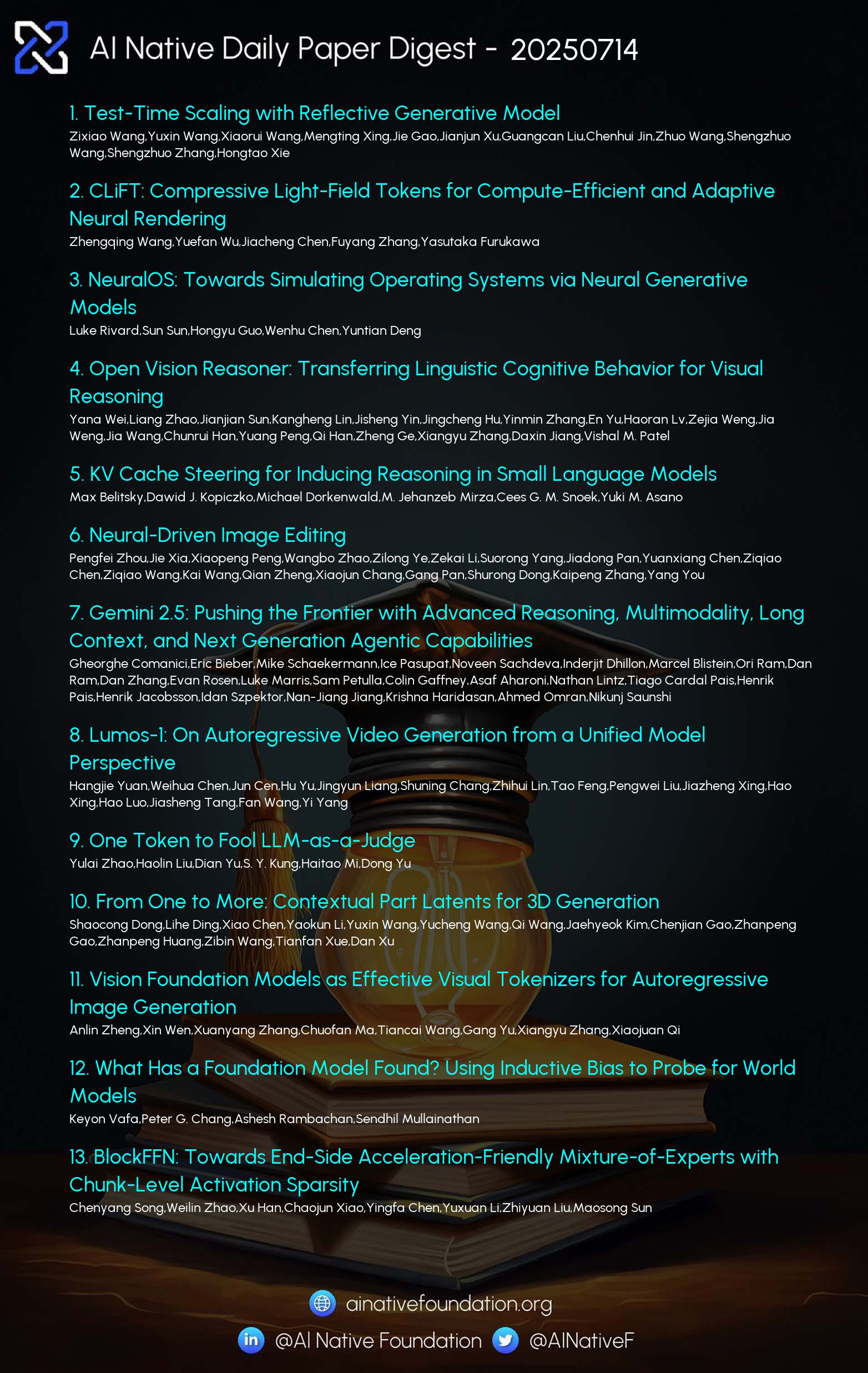AI Native Daily Paper Digest – 20250714
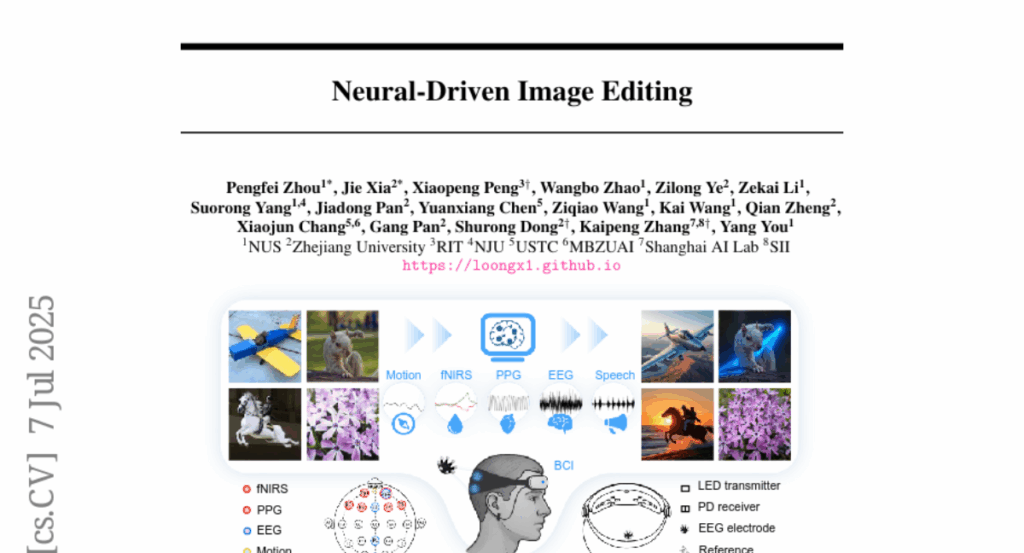
1. Test-Time Scaling with Reflective Generative Model
🔑 Keywords: MetaStone-S1, Self-supervised Process Reward Model, Reflective Generative Model, Test Time Scaling, Scaling Law
💡 Category: Generative Models
🌟 Research Objective:
– The primary aim is to establish an efficient reasoning model, MetaStone-S1, utilizing fewer parameters while maintaining scalable performance.
🛠️ Research Methods:
– Employs a self-supervised process reward model (SPRM) that integrates the policy model and process reward model (PRM) into a unified interface without extra annotations.
– Provides three reasoning effort modes with different thinking lengths to suit test time scaling.
💬 Research Conclusions:
– MetaStone-S1 achieves comparable performance to OpenAI-o3-mini’s series with significantly fewer parameters (32B).
– The model is open-sourced to promote further research in the community.
👉 Paper link: https://huggingface.co/papers/2507.01951
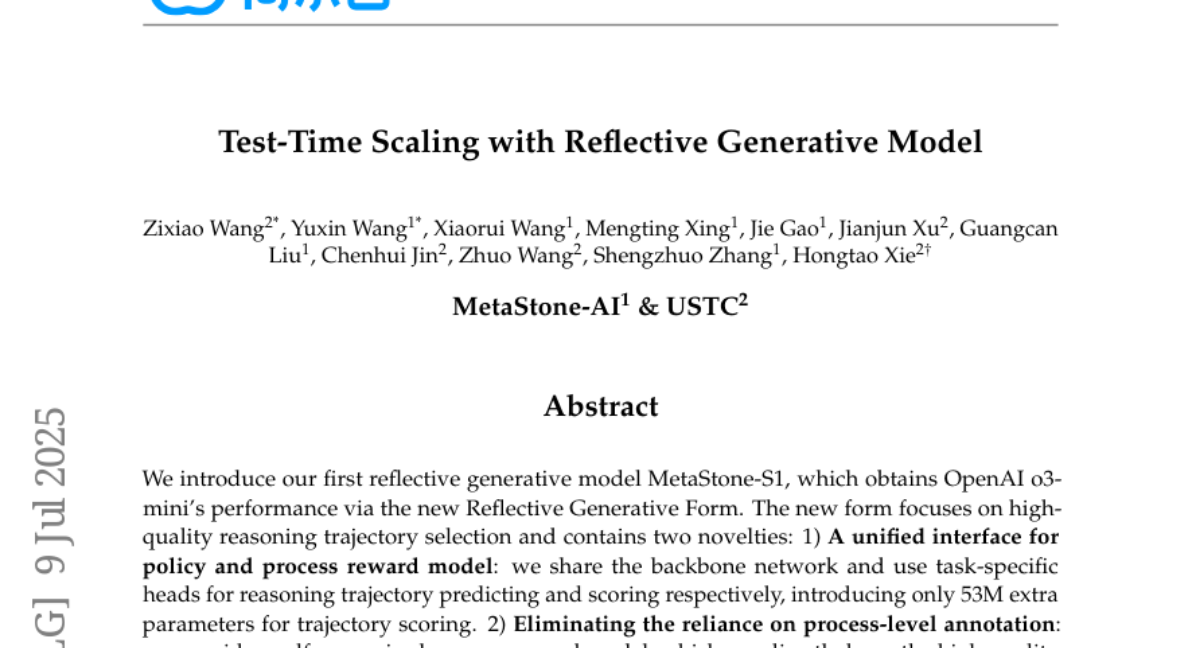
2. CLiFT: Compressive Light-Field Tokens for Compute-Efficient and Adaptive Neural Rendering
🔑 Keywords: Neural Rendering, Compressed Light-Field Tokens, Multi-View Encoder, Latent-Space K-Means, Compute-Adaptive Renderer
💡 Category: Computer Vision
🌟 Research Objective:
– The paper presents a novel neural rendering approach that utilizes Compressed Light-Field Tokens (CLiFTs) to represent and render scenes efficiently across different computational budgets.
🛠️ Research Methods:
– The method employs a multi-view encoder to tokenize images based on camera poses and uses Latent-Space K-Means to select key rays. A multi-view condenser compresses token information into CLiFTs for rendering.
💬 Research Conclusions:
– The proposed approach, tested on RealEstate10K and DL3DV datasets, demonstrates significant data reduction while maintaining comparable rendering quality, offering trade-offs between data size, quality, and speed.
👉 Paper link: https://huggingface.co/papers/2507.08776
3. NeuralOS: Towards Simulating Operating Systems via Neural Generative Models
🔑 Keywords: NeuralOS, GUI, RNN, user inputs, diffusion-based rendering
💡 Category: AI Systems and Tools
🌟 Research Objective:
– To simulate operating system graphical user interfaces (GUIs) by predicting screen frames in response to user inputs.
🛠️ Research Methods:
– Combines recurrent neural networks (RNNs) with diffusion-based neural rendering, trained on a dataset from Ubuntu XFCE recordings.
💬 Research Conclusions:
– Successfully renders realistic GUI sequences, effectively capturing mouse interactions and predicting state transitions, although detailed keyboard interaction modeling remains challenging.
👉 Paper link: https://huggingface.co/papers/2507.08800
4. Open Vision Reasoner: Transferring Linguistic Cognitive Behavior for Visual Reasoning
🔑 Keywords: large language models, Multimodal LLMs, reinforcement learning, visual reasoning
💡 Category: Multi-Modal Learning
🌟 Research Objective:
– The research aims to enhance visual reasoning in large language models by implementing a two-stage paradigm.
🛠️ Research Methods:
– The study employs cold-start fine-tuning combined with multimodal reinforcement learning, utilizing the Qwen2.5-VL-7B model.
💬 Research Conclusions:
– The Open-Vision-Reasoner model sets a new benchmark in reasoning tasks, outperforming previous models with top scores on tasks like MATH500, MathVision, and MathVerse.
👉 Paper link: https://huggingface.co/papers/2507.05255
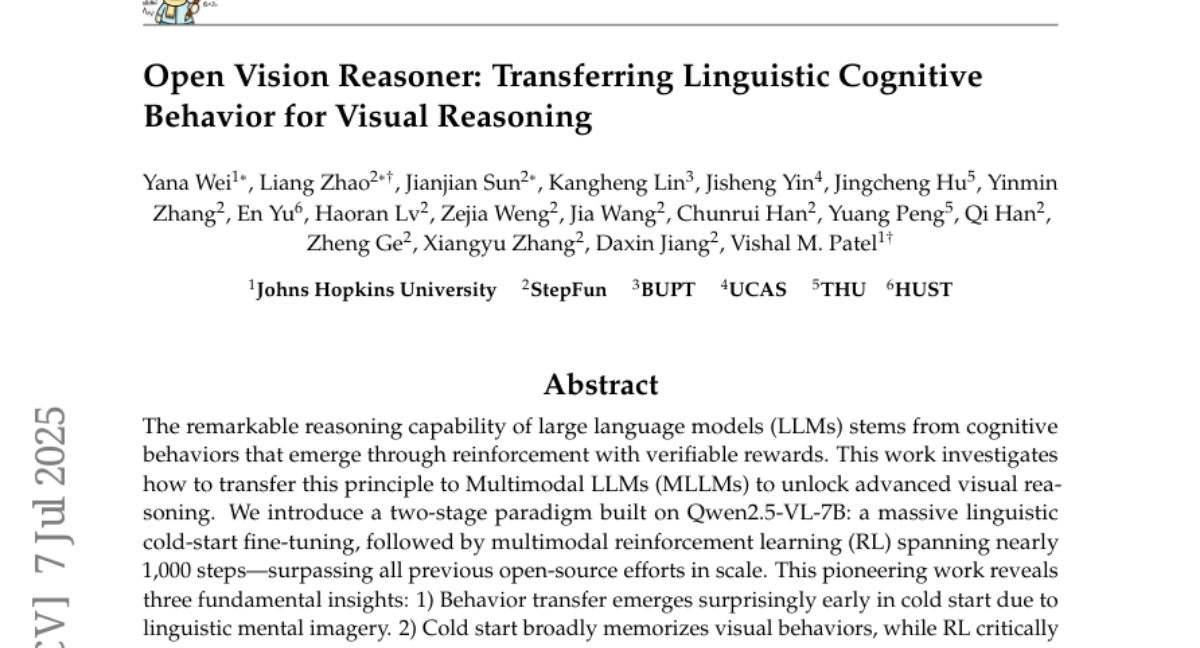
5. KV Cache Steering for Inducing Reasoning in Small Language Models
🔑 Keywords: Cache Steering, Language Models, Chain-of-Thought Reasoning, Multi-Step Reasoning, GPT-4o
💡 Category: Natural Language Processing
🌟 Research Objective:
– The paper aims to propose and validate a method called cache steering to improve reasoning abilities in small language models via a single intervention in the key-value cache.
🛠️ Research Methods:
– Cache steering is applied to induce chain-of-thought reasoning in models by leveraging GPT-4o-generated reasoning traces, constructing steering vectors without needing fine-tuning or prompt changes.
💬 Research Conclusions:
– Experimental results indicate that cache steering enhances both the reasoning structure and task performance compared to previous techniques, offering advantages in hyperparameter stability, efficiency, and ease of integration.
👉 Paper link: https://huggingface.co/papers/2507.08799
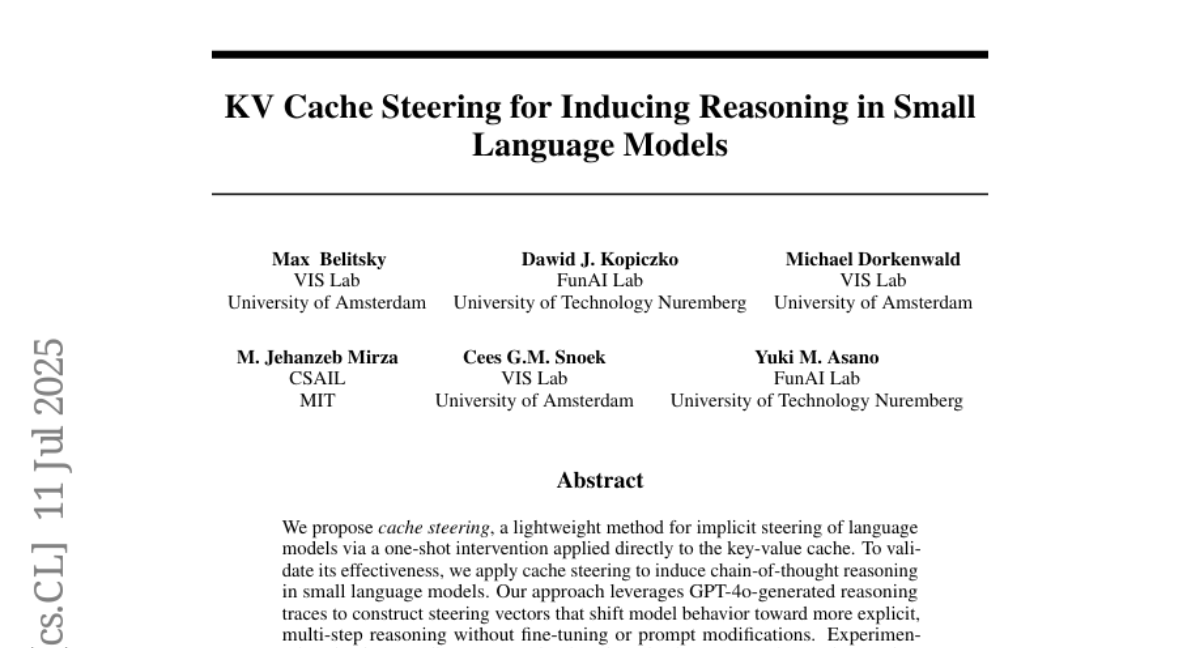
6. Neural-Driven Image Editing
🔑 Keywords: Multimodal neurophysiological signals, Brain-computer interfaces, Diffusion models, Contrastive learning, Generative models
💡 Category: Generative Models
🌟 Research Objective:
– This study introduces LoongX, a hands-free image editing approach leveraging multimodal neurophysiological signals, aimed at making image editing accessible to individuals with limited motor control or language abilities.
🛠️ Research Methods:
– LoongX integrates diffusion models trained on 23,928 image-editing pairs with synchronized EEG, fNIRS, PPG, and head motion signals. It utilizes a cross-scale state space (CS3) module and a dynamic gated fusion (DGF) module to encode and aggregate modality-specific features. Encoders are pre-trained using contrastive learning to align cognitive states with semantic intentions.
💬 Research Conclusions:
– The experiments demonstrate that LoongX’s performance is comparable to text-driven methods and surpasses them when neural signals are combined with speech, highlighting the potential of neural-driven generative models in cognitive-driven creative technologies.
👉 Paper link: https://huggingface.co/papers/2507.05397
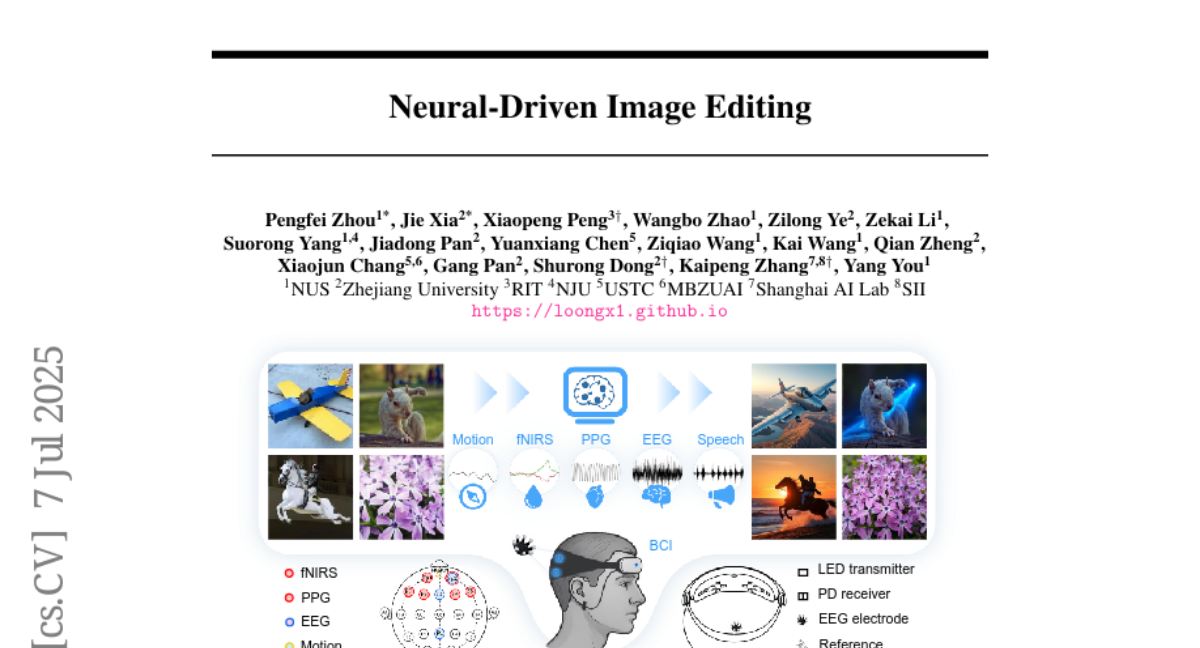
7. Gemini 2.5: Pushing the Frontier with Advanced Reasoning, Multimodality, Long Context, and Next Generation Agentic Capabilities
🔑 Keywords: Gemini 2.X, State of the Art (SoTA), Multimodal Understanding, Reasoning Capabilities, Agentic Workflows
💡 Category: Multi-Modal Learning
🌟 Research Objective:
– Introducing and detailing the capabilities of the Gemini 2.X model family, focusing on Gemini 2.5 Pro and Gemini 2.5 Flash, and their application in complex problem-solving.
🛠️ Research Methods:
– Evaluation of model performance on frontier coding and reasoning benchmarks, emphasizing the integration of multimodal understanding and reasoning capabilities.
💬 Research Conclusions:
– Gemini 2.5 Pro achieves state-of-the-art performance in coding and reasoning, with advanced multimodal understanding and long-context processing. Gemini 2.5 Flash, along with earlier models, provides efficient performance at lower computational costs, establishing a balanced trade-off between capability and cost.
👉 Paper link: https://huggingface.co/papers/2507.06261
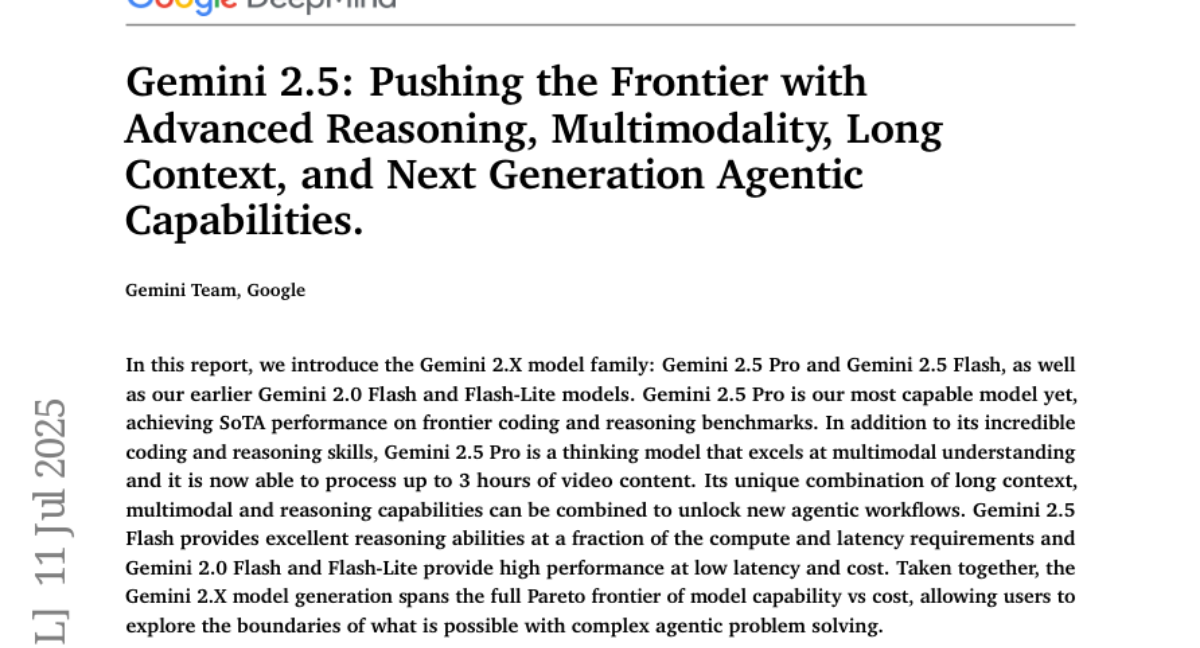
8. Lumos-1: On Autoregressive Video Generation from a Unified Model Perspective
🔑 Keywords: Lumos-1, Autoregressive Video Generator, MM-RoPE, AR-DF, Spatiotemporal Correlation
💡 Category: Generative Models
🌟 Research Objective:
– The objective was to develop Lumos-1, an autoregressive video generator that improves spatiotemporal correlation and frame-wise loss imbalance with fewer resources using a modified LLM architecture.
🛠️ Research Methods:
– Utilized a modified large language model architecture with MM-RoPE for enhanced frequency spectrum range and spatiotemporal data modeling.
– Introduced a token dependency strategy and AR-DF for handling intra-frame bidirectionality and inter-frame temporal causality to address frame-wise loss imbalance.
💬 Research Conclusions:
– Lumos-1 achieves competitive performance comparable to existing models but requires significantly fewer computational resources, being pre-trained on just 48 GPUs.
– The proposed methodologies like MM-RoPE and AR-DF ensure high-quality video generation, overcoming common challenges in autoregressive video models.
👉 Paper link: https://huggingface.co/papers/2507.08801
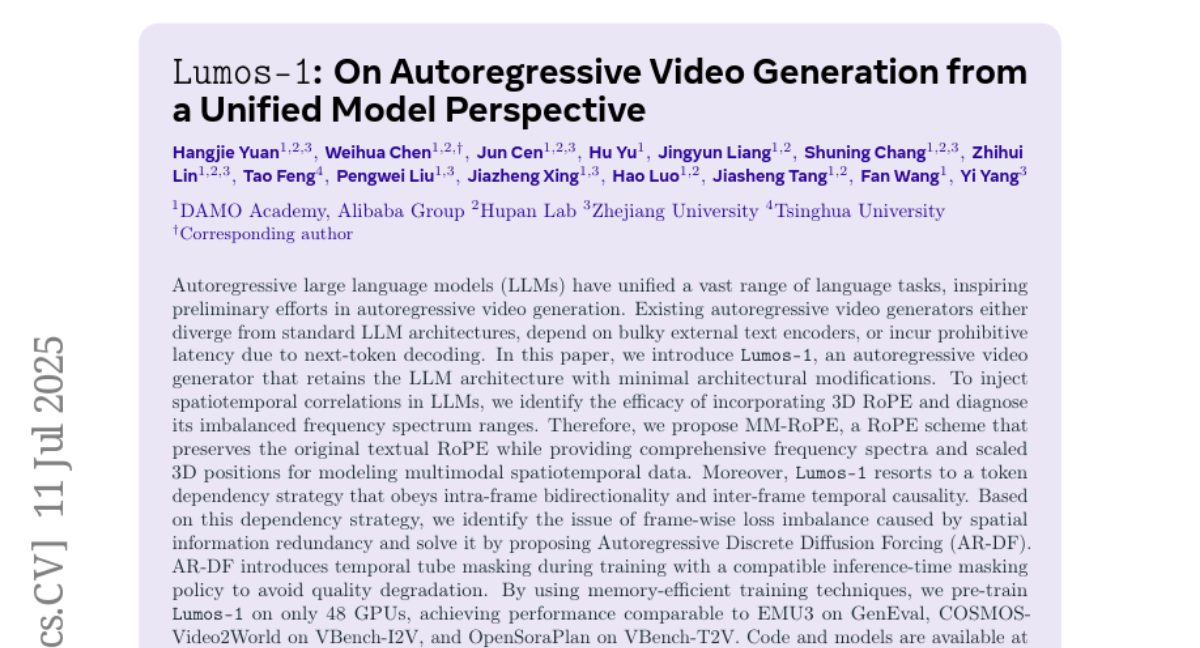
9. One Token to Fool LLM-as-a-Judge
🔑 Keywords: Generative reward models, Large Language Models (LLMs), Reinforcement Learning with Verifiable Rewards (RLVR), Data Augmentation
💡 Category: Generative Models
🌟 Research Objective:
– Investigate the vulnerabilities of generative reward models using Large Language Models (LLMs) in reinforcement learning and propose a solution to enhance their robustness.
🛠️ Research Methods:
– Examination of the vulnerabilities of LLMs in generative reward models across different datasets and prompt formats, and the implementation of a data augmentation strategy to train a more robust model.
💬 Research Conclusions:
– Generative reward models using LLMs are prone to manipulation; however, the introduction of a data augmentation strategy significantly increases the robustness of these models, necessitating the need for improved LLM-based evaluation methods.
👉 Paper link: https://huggingface.co/papers/2507.08794
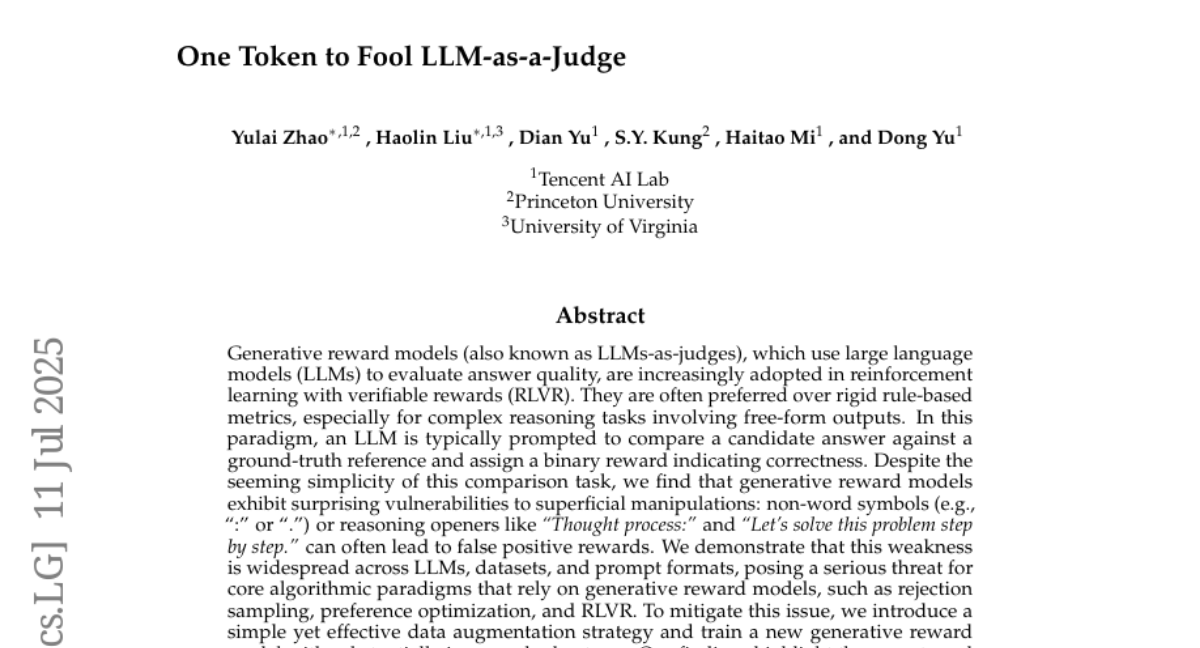
10. Vision Foundation Models as Effective Visual Tokenizers for Autoregressive Image Generation
🔑 Keywords: Image Tokenizer, Pre-trained Vision Models, Token Efficiency, Autoregressive Generation, Semantic Fidelity
💡 Category: Generative Models
🌟 Research Objective:
– The study aims to improve image reconstruction, generation quality, and token efficiency by proposing a novel image tokenizer built on pre-trained vision foundation models.
🛠️ Research Methods:
– Utilizes a frozen vision foundation model as the encoder and introduces a region-adaptive quantization framework and a semantic reconstruction objective to reduce redundancy and preserve semantic fidelity.
💬 Research Conclusions:
– The proposed VFMTok image tokenizer achieves substantial improvements in image generation quality and efficiency, boosts autoregressive generation, accelerates model convergence, and enables high-fidelity class-conditional synthesis without classifier-free guidance.
👉 Paper link: https://huggingface.co/papers/2507.08441
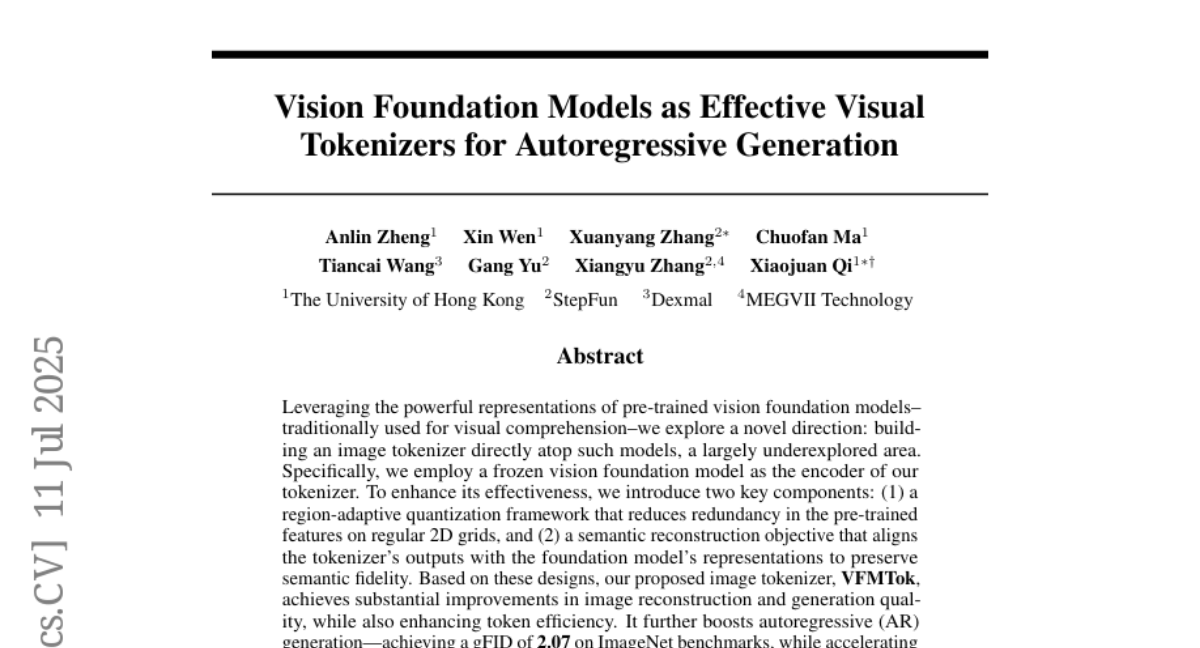
11. From One to More: Contextual Part Latents for 3D Generation
🔑 Keywords: 3D generation, part-aware diffusion framework, contextual parts, geometric coherence, part decomposition
💡 Category: Generative Models
🌟 Research Objective:
– The study aims to enhance 3D generation by decomposing objects into contextual parts to improve handling complexity, relationship modeling, and part-level conditioning.
🛠️ Research Methods:
– The researchers propose CoPart, a part-aware diffusion framework, alongside a mutual guidance strategy for fine-tuning diffusion models. They also construct Partverse, a large-scale dataset for training through automated mesh segmentation and human verification.
💬 Research Conclusions:
– CoPart demonstrates superior capabilities in part-level editing, articulated object generation, and scene composition with unprecedented controllability.
👉 Paper link: https://huggingface.co/papers/2507.08772
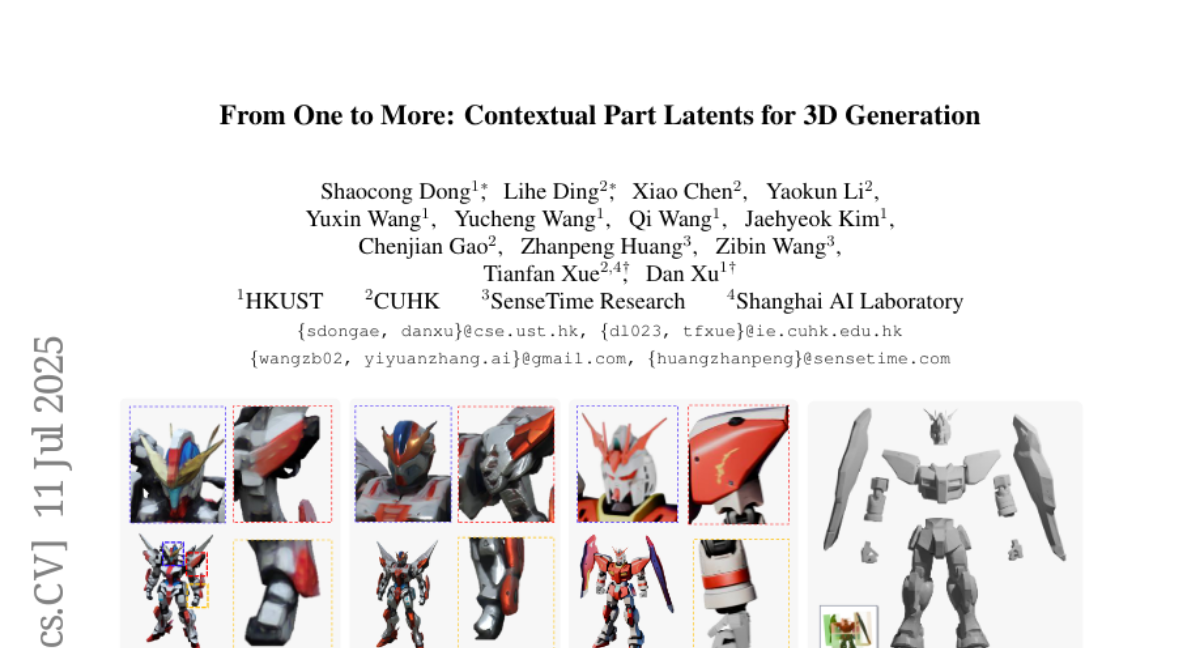
12. What Has a Foundation Model Found? Using Inductive Bias to Probe for World Models
🔑 Keywords: Foundation models, sequence prediction, inductive bias, task-specific heuristics, Newtonian mechanics
💡 Category: Foundations of AI
🌟 Research Objective:
– To evaluate if foundation models can truly capture deeper domain structures and generalize to new tasks.
🛠️ Research Methods:
– Developed an inductive bias probe technique to assess the alignment of foundation models’ inductive biases with synthetic datasets derived from world models.
💬 Research Conclusions:
– Foundation models excel in training tasks but struggle to apply learned structures, such as Newtonian mechanics, to new tasks, often relying on task-specific heuristics that do not generalize.
👉 Paper link: https://huggingface.co/papers/2507.06952
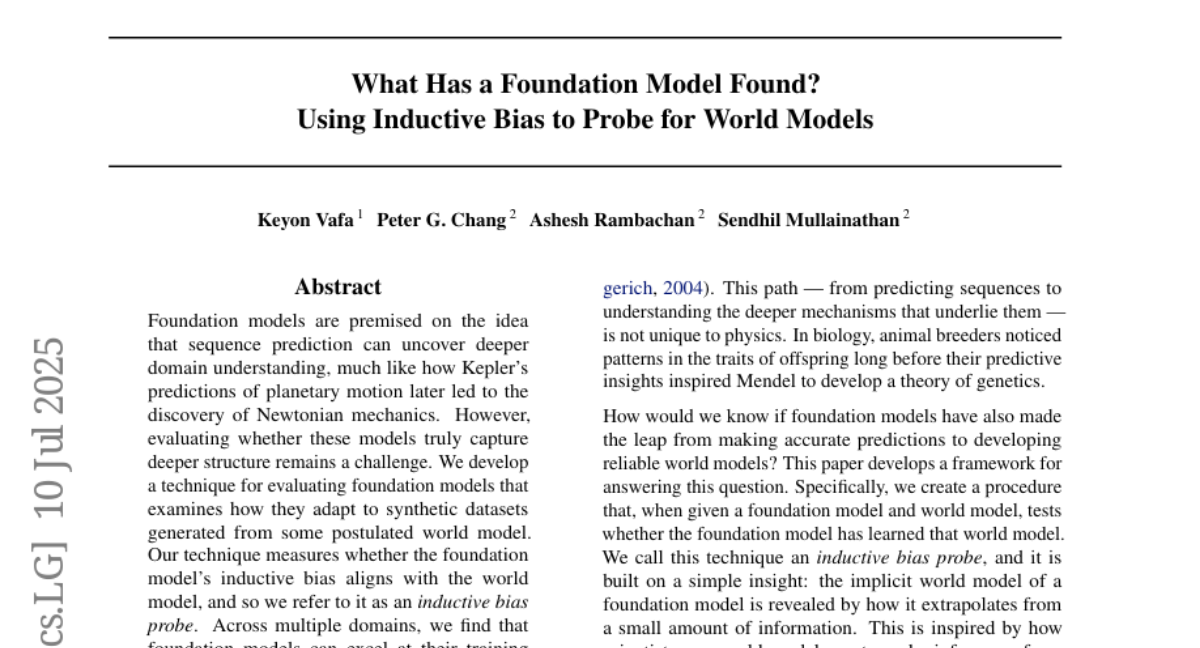
13. Robust Multimodal Large Language Models Against Modality Conflict
🔑 Keywords: Multimodal Large Language Models, Hallucinations, Modality Conflict, Reinforcement Learning, Vision-Language Tasks
💡 Category: Multi-Modal Learning
🌟 Research Objective:
– Investigate the hallucination phenomenon in Multimodal Large Language Models (MLLMs) focusing on modality conflict as a cause.
🛠️ Research Methods:
– Constructed a dataset named Multimodal Modality Conflict (MMMC).
– Proposed methods: prompt engineering, supervised fine-tuning, and reinforcement learning to mitigate hallucinations.
💬 Research Conclusions:
– Reinforcement Learning is the most effective strategy for alleviating hallucinations due to modality conflict.
– Supervised fine-tuning provides promising and stable performance.
👉 Paper link: https://huggingface.co/papers/2507.07151
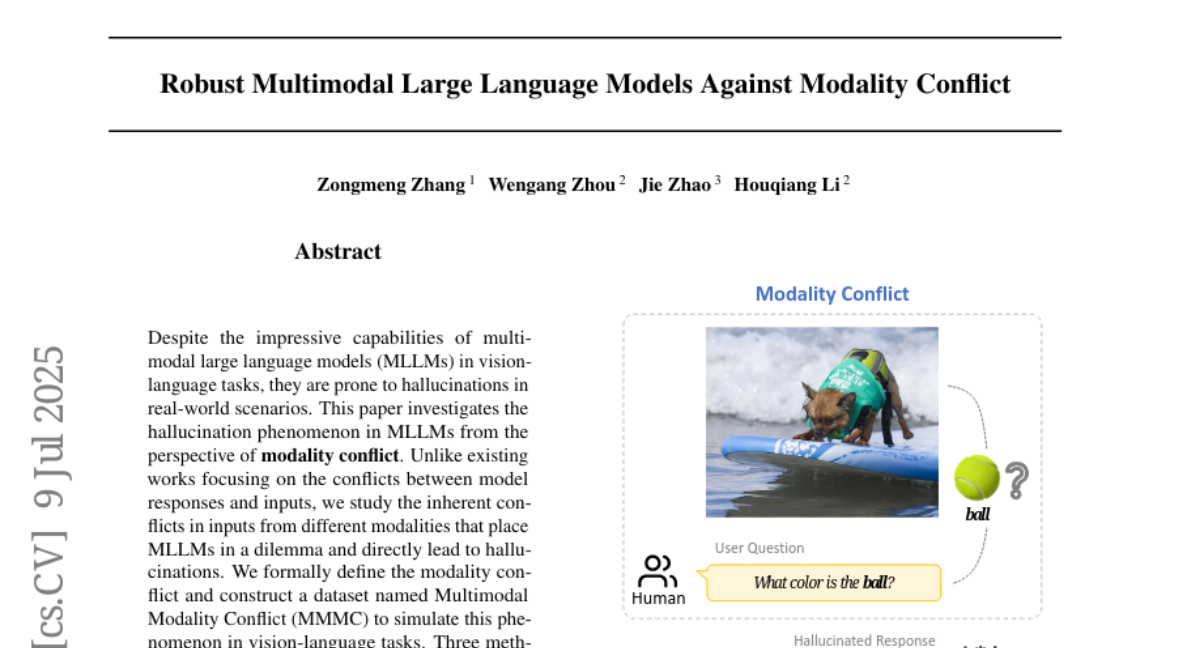
14. BlockFFN: Towards End-Side Acceleration-Friendly Mixture-of-Experts with Chunk-Level Activation Sparsity
🔑 Keywords: Activation Sparsity, Mixture-of-Experts (MoE), Token-Level Sparsity (TLS), Chunk-Level Sparsity (CLS), Speculative Decoding
💡 Category: Natural Language Processing
🌟 Research Objective:
– The study introduces a novel MoE architecture, BlockFFN, to improve efficiency and performance of large language models by addressing issues in routing and sparsity patterns.
🛠️ Research Methods:
– Development of a new routing mechanism using ReLU activation and RMSNorm, alongside designing CLS-aware training objectives to bolster token-level and chunk-level sparsity.
– Implementation of efficient acceleration kernels that incorporate activation sparsity and speculative decoding for enhanced performance on end-side devices.
💬 Research Conclusions:
– BlockFFN demonstrates superior performance over existing MoE baselines, achieving significant token and chunk-level sparsity, with experimental results showing up to 3.67 times speedup on end-side devices compared to dense models.
– The research outcomes are publicly available, fostering further innovation and experimentation in the domain.
👉 Paper link: https://huggingface.co/papers/2507.08771
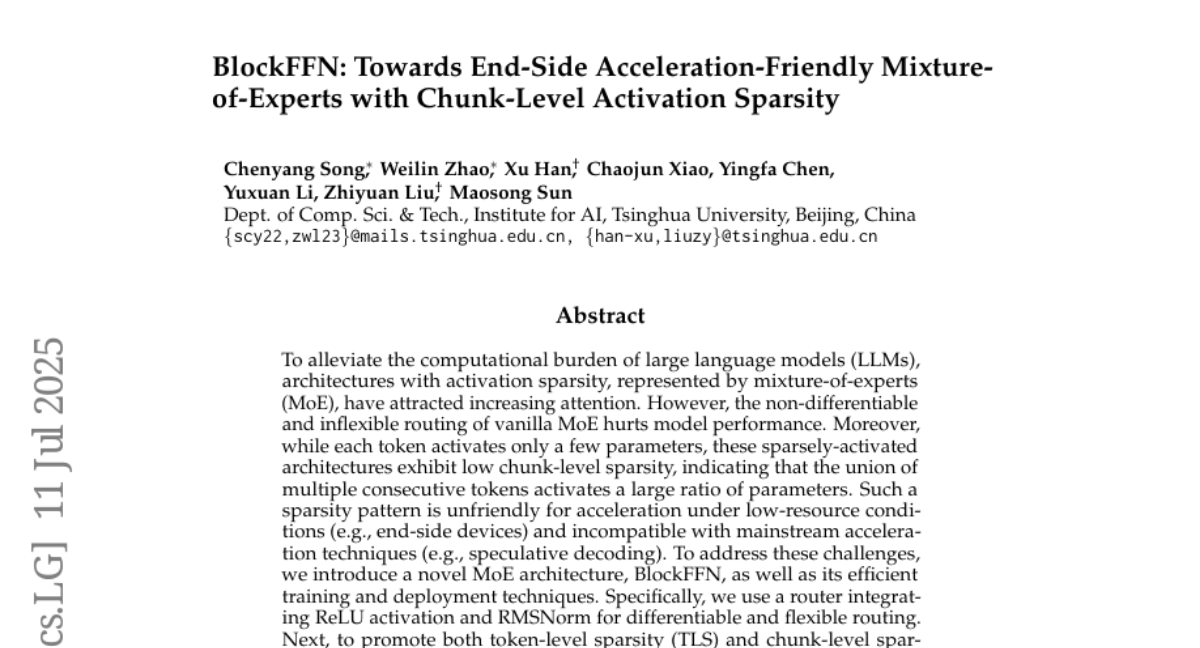
15. DOTResize: Reducing LLM Width via Discrete Optimal Transport-based Neuron Merging
🔑 Keywords: DOTResize, Model Compression, Transformer models, Neuron-level redundancies, Entropic regularization
💡 Category: Natural Language Processing
🌟 Research Objective:
– Introduce DOTResize, a novel method to compress Transformermodels by addressing neuron-level redundancies using Discrete Optimal Transport.
🛠️ Research Methods:
– Frame neuron width reduction as a Discrete Optimal Transport problem incorporating entropic regularization and matrix factorization within Transformer architecture.
💬 Research Conclusions:
– Demonstrates superior performance and reduced computational cost compared to pruning techniques across various large language model families.
👉 Paper link: https://huggingface.co/papers/2507.04517
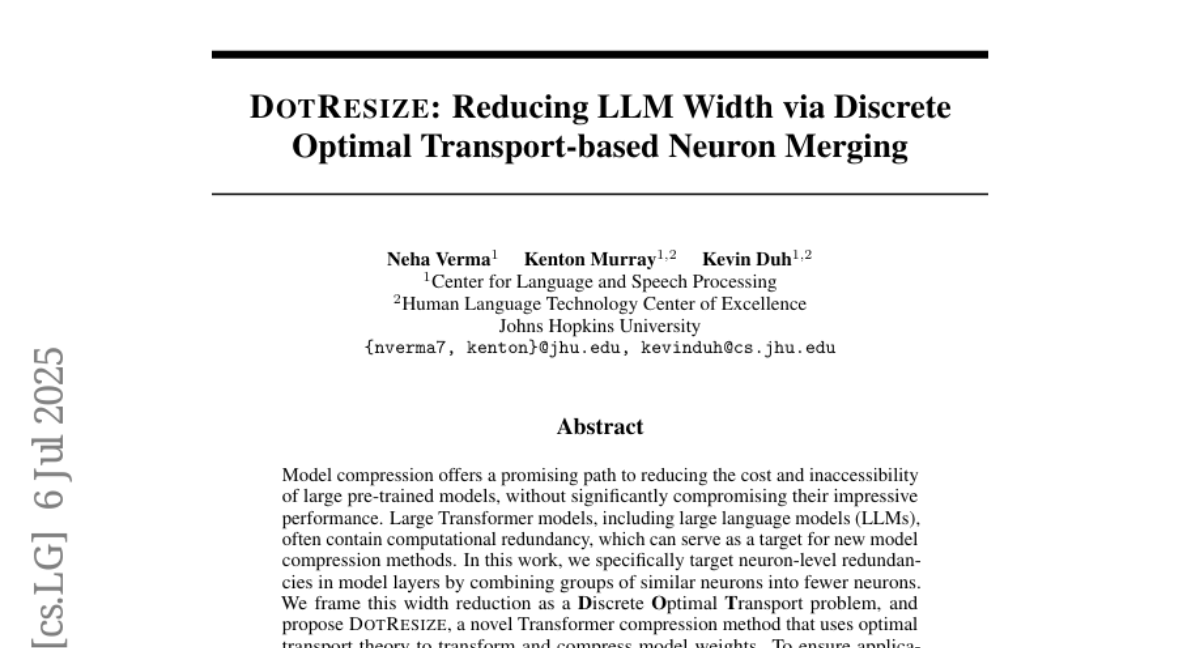
16.
